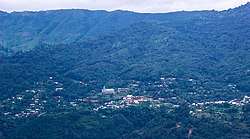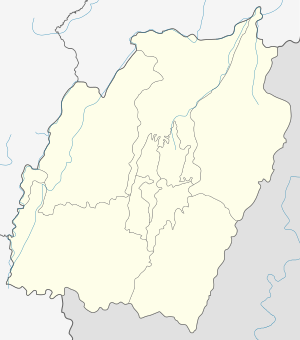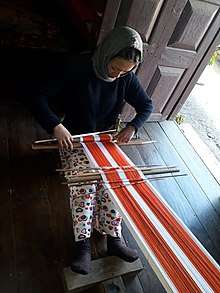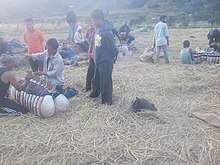Phalee
Phalee also called as Phadang is a village located west of Ukhrul in Ukhrul district, Manipur state in India. It lies in the Indo-Burma Biodiversity Hot-Spot Region of the world wherein the flora and fauna diversity are very rich [1]. It occupies total area of about 49 sq. km. It has Red Sandy Soils and annual rainfall of 2000-2400mm. It has subtropical pine forest climate with distinct four seasons. The average temperature is in the range of 23°C. It experienced reverse monsoon in winter and four distinct seasons. As per 2011 census,[2] the village has a total of 794 households with 3742 persons of which 1934 are male while 1808 are female. Of the total population, 11.60% are in the age group of 0–6 years. The average sex ratio of the village is 904 female per 1000 male. The literacy rate of the village is 81.35%. Phalee is flanked by Ngaimu and Tolloi in the East, Somdal and Hoomi north, Tuinem and Lamlang in the south and Champhung and Tora in the west. The village is assumed to be more than 600 years (approximate) since the first settler settled in relation to the sixteen generation back. The village has a total of 794 households with 3742 persons of which 1934 are male while 1808 are female. The average sex ratio of the village is 904 females per 1000 male. The literacy rate of the village is 81.35% [2].
Phalee Phadang | |
|---|---|
Village | |
 | |
 Phalee Location in Manipur, India  Phalee Phalee (India) | |
| Coordinates: 25°08′33″N 94°17′02″E | |
| Country | |
| State | Manipur |
| District | Ukhrul |
| Population | |
| • Total | 3,742 |
| Languages | |
| • Official | Phalee Tangkhul |
| Time zone | UTC+5:30 (IST) |
| PIN | 795144 |
| Vehicle registration | MN |
| Nearest city | Ukhrul |
| Literacy | 81.35% |
| Lok Sabha constituency | Outer Manipur |
| Vidhan Sabha constituency | Chingai |
| Website | manipur |
Organization
- Headman
- Village Authority
- PNBC
- Women Society
- Shanao Long
- Phalee Consultation Conference
- Yarnao Long
- Phalee Youth Organisation
- Phalee Football Clubs
- (Clan) Shangnao Funds
- Tang
- CYS
- Phalee Preingnao Picnic Party
- Phalee Biodiversity Management Committee [3][4][5]
It is a small village which values democracy that is evidently clear from its diverse organizations within the village. It has its own customary constitution for their village functioning.
Phalee Biodiversity Management Committee (Phalee BMC) is an organisation which is elected by the villagers to work on Environment and Biodiversity [6] conservation of the village in accordance with the Biological Diversity Act, 2002 [3][7]. It also works on recording and documentation of the village and surrounding areas flora and fauna. It is the first institute among the villages of Ukhrul District that established Biodiversity Zone [4], recorded, documented and cataloged flora and fauna of the region on its founded group Rainforest Biodiversity of Phalee [5] within India Biodiversity Portal [8] [5]. Some of the main objectives of Phalee BMC are Preservation, Conservation, and Education of Biodiversity and People’s Culture . It also works on village Heritage [4].
Religion and educational institutions
Phalee is one of the Tangkhul villages that embraced Christianity very early. For this, the villagers got access to western education right from the coming of Christian missionaries to Ukhrul district [9].According to the 2011 census, the literacy rate of the village was 81.35% which is higher than the state's average of 76.94% [2].
People and occupation
The village is home to people of Tangkhul Naga tribe and speak Tangkhul language [10][11].Agriculture is the primary occupation of the inhabitants. Rice, maize, potato, and cabbage are the main crops grown in Phalee [12]. The traditional farming system has been an integral part of this village livelihood since time immemorial and accordingly, it is closely interwoven with the intricate fabric of the society in culture, religions, and economy [13]. The farming system covers wet paddy cultivation, slash and burn (jhuming) and the other allied agricultural activities comprising forest gathering, artisanship, crop festivals, kitchen gardening, domestication of birds and animals, fisheries, and rearing of edible insects [14]. Rearing edible six-legged insects like Asian giant hornet (Vespa mandarinia), honey bees, green grasshoppers, etc.
Most of these practices are social and community-based activity and their importance is pertinently expressed in their various culture [15]. They are very old practices and the production system are generally trivial, merely a paltry self-sufficient to safeguard the basic level of survival. The agriculture system is stagnated which is proved by the unremitting abject poverty of the village life [16] plagued with malnutrition, ill health and lack of basic amenities like telecommunications, transport, and marketing [13]. However, in recent year there is a tremendous improvement in the rearing of the domestic animal and bird and especially fishery, producing approximately 1000 kg of fish (common carp and other local variety) per year [17]. It is of one the village that upholds afforestation programme with Government agencies with huge success and one of the villages that planted the highest number of trees thus far [18].
Artisanship is one of the old traditional practises of this village which include weaving, blacksmith, bamboo weaving, stone and wood carving works etc [19]. The artisanship constitute one of the basic scale of their development index in the past.
Culture
Luira Phanit or the seed-sowing festival is perhaps still one of the biggest traditional festivals of the Tangkhuls Naga which are celebrated every year with great pomp and joy. This is a festival celebrated in every Tangkhul village at the beginning of the year though with some modifications now (the date of celebration differs from village to village), precisely to herald the coming of a new year and to commemorate the beginning of sowing the first seed for the coming year [20].This is the main agricultural festival of the year and its celebration spread over a period of about eleven days in the olden days though the celebration does not extend that much longer nowadays.
Since the advent of Christianity [21] and in the years that followed, an understanding between the Christians and the non-Christians of this village was brought about in regard to the fixation of the date for its celebration wherein, 15 – 20 March of every year was exclusively set aside for this festival of which, hitherto it was usually celebrated a little earlier than this. So it's almost a week-long celebration and even now the intensity of the celebration is quite immense. Some of the competition items during the festival includes folk song (this includes Yarra Laa, Ngakhakva Laa and Phalee Awungashi Laa), folk dance, Luita Laa, high jump, long jump, wrestling, bamboo climbing, carrying rice pounding stick on the back, tug of war, trumpet, flute, violin, guitar and many more [12]. Tug of war is one showpiece of an event that really captivates the hearts of the audience with equal numbers of men and women at each end of the rope trying to pull with their utmost strength.
The dying giant may not figuratively represent a human giant but it’s about the practice, tradition of carrying a giant load of paddy [22] (Lengvei Kaphung) a popular age-old practice among Tangkhul Nagas during harvest time in Phalee village too, situated in the west of Ukhrul district in Manipur [23]. Lengvei Kaphung is a challenge for all men of the village. A giant load of paddy tightly packed in traditional specially hand weaved shawls weighs more than 300 kgs or 3 quintals of paddy.The handicrafts using bamboo sliver is another skill which is hand weaved into different shape and size of baskets for the different household purposes like containers, carpet and decorations .
References
- Myers, N.; Mittermeier, R. A.; Mittermeier, C. G.; Da Fonseca, G. A.; Kent, J. (2000). "Biodiversity hotspots for conservation priorities". Nature. 403 (6772): 853–858. doi:10.1038/35002501. PMID 10706275.
- "Villages in Ukhrul district". Census 2011. Retrieved 20 August 2015.
- "Phalee Biodiversity Management Committee". India Biodiversity Portal. Retrieved 24 February 2020.
- "Phalee Biodiversity Observatory Station". phalee-biodiversity-observatory-station.business.site. Retrieved 24 February 2020.
- "Rainforest Biodiversity of Phalee". Rainforest Biodiversity of Phalee - India Biodiversity Portal. Retrieved 24 February 2020.
- "Home | Convention on Biological Diversity". www.cbd.int. Retrieved 25 February 2020.
- "NATIONAL BIODIVERSITY AUTHORITY - Biodiversity Management Committees". nbaindia.org. Retrieved 11 March 2020.
- "India Biodiversity Portal". India Biodiversity Portal. Retrieved 29 April 2020.
- "William Pettigrew (1869 – 1943) – Royal Asiatic Society". Retrieved 24 February 2020.
- "Spoken L1 Language: East-Central Tangkhul Naga". Glottolog.
- "Did you know Tangkhul Naga is endangered?". Endangered Languages. Retrieved 24 February 2020.
- "Phalee Luita Phanit Seed sowing festival oral tradition and cultural orientation By OT Ramshan". www.e-pao.net. Retrieved 24 February 2020.
- "Snags of timeworn small farming system of Phalee village Manipur By Ng Ngalengshim". www.e-pao.net. Retrieved 24 February 2020.
- "Insects for food and feed". www.fao.org. Retrieved 11 March 2020.
- "UNPO: Naga: Culture on Display in Switzerland". unpo.org. Retrieved 24 February 2020.
- "Dynamics of Ganja Cultivation in Manipur". Economic and Political Weekly: 7–8. 5 June 2015.
- "The Wet Paddy Cultivation in Hills of Manipur By Ngashangva Ngalengshim". e-pao.net. Retrieved 24 February 2020.
- "The reforestation of waste land with wild edible fruit trees By Ngashangva Ransing Ramshan". e-pao.net. Retrieved 24 February 2020.
-

- "lui ngai ni". e-pao.net. Retrieved 24 February 2020.
- Kapai, Yuimirin (1 October 2019). "William Pettigrew: Mythicizing the Man and His Work". International Bulletin of Mission Research. 43 (4): 358–367. doi:10.1177/2396939319836882. ISSN 2396-9393.
-

- "Saving Lengvei, the dying giant : 23rd nov11 ~ E-Pao! Headlines". e-pao.net. Retrieved 24 February 2020.
External links
- Introducing village on climate change. e-pao.net › education › Science and Technology
- The reforestation of wasteland with wild edible fruit trees. e-pao.net › education › Science and Technology
- Snags of timeworn small farming system of Phalee village Manipur. e-pao.net › education › Science and Technology
- Phalee Luita Phanit Seed sowing festival oral tradition and cultural. e-pao.net › manipur › Festival of Manipur
- The Wet Paddy Cultivation in Hills of Manipur. e-pao.net › education › Science and Technology
- "Phalee", a documentary film made by Yirmiyan Arthur as a part of the Panos Fellowship programme.UNPO: Naga: Culture on Display in Switzerland unpo.org/article/9344
- The documentary on "the dying giant" a popular age-old practice among Tangkhul Nagas during harvest time in Phalee village, Ukhrul district, Manipur.www.nagalandpost.com/ChannelNews/State/StateNews.aspx?news
- William Pettigrew (1869 – 1943).
- Colonialism, Reverend William Pettigrew (1869-1943), and the Coming of Christianity and Western Education to Manipurhttp://www.easternmirrornagaland.com/colonialism-reverend-william-pettigrew-1869-1943-and-the-coming-of-christianity-and-western-education-to-manipur/
- The YOUTH GUIDE to BIODIVERSITY. www.fao.org/docrep/017/i3157e/i3157e00.htm
- Food security: your questions answered | University of Cambridge. https://www.cam.ac.uk/research/discussion/food-security-your-questions-answered.